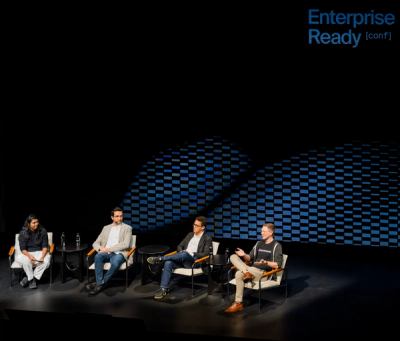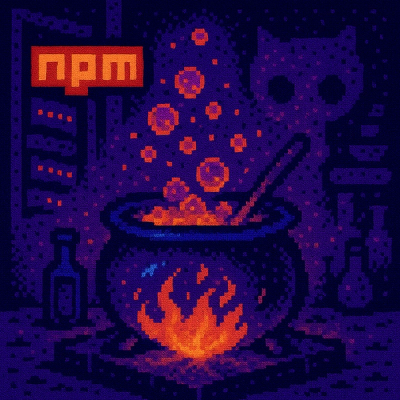
Security News
How Enterprise Security Is Adapting to AI-Accelerated Threats
Socket CTO Ahmad Nassri discusses why supply chain attacks now target developer machines and what AI means for the future of enterprise security.
gradio-legacyimage
Advanced tools
gradio_legacyimagePython library for easily interacting with trained machine learning models
pip install gradio_legacyimage
import numpy as np
import gradio as gr
from gradio_legacyimage import LegacyImage
def process(x):
flip = x.copy()
flip["back"] = np.fliplr(flip["back"])
mask = x.copy()
mask["back"] = mask["mask"]
return x, flip, mask
with gr.Blocks() as demo:
with gr.Column():
im1 = LegacyImage(source="upload", type="pil", tool="sketch")
im2 = LegacyImage()
im3 = LegacyImage()
im4 = LegacyImage()
btn = gr.Button()
btn.click(process, inputs=im1, outputs=[im2, im3, im4])
if __name__ == "__main__":
demo.launch()
LegacyImage| name | type | default | description |
|---|---|---|---|
value |
| None | A PIL LegacyImage, numpy array, path or URL for the default value that LegacyImage component is going to take. If callable, the function will be called whenever the app loads to set the initial value of the component. |
height |
| None | Height of the displayed image in pixels. |
width |
| None | Width of the displayed image in pixels. |
image_mode |
| "RGB" | "RGB" if color, or "L" if black and white. See https://pillow.readthedocs.io/en/stable/handbook/concepts.html for other supported image modes and their meaning. |
type |
| "numpy" | The format the image is converted to before being passed into the prediction function. "numpy" converts the image to a numpy array with shape (height, width, 3) and values from 0 to 255, "pil" converts the image to a PIL image object, "filepath" passes a str path to a temporary file containing the image. |
label |
| None | The label for this component. Appears above the component and is also used as the header if there are a table of examples for this component. If None and used in a `gr.Interface`, the label will be the name of the parameter this component is assigned to. |
every |
| None | If `value` is a callable, run the function 'every' number of seconds while the client connection is open. Has no effect otherwise. Queue must be enabled. The event can be accessed (e.g. to cancel it) via this component's .load_event attribute. |
show_label |
| None | if True, will display label. |
show_download_button |
| True | If True, will display button to download image. |
container |
| True | If True, will place the component in a container - providing some extra padding around the border. |
scale |
| None | relative width compared to adjacent Components in a Row. For example, if Component A has scale=2, and Component B has scale=1, A will be twice as wide as B. Should be an integer. |
min_width |
| 160 | minimum pixel width, will wrap if not sufficient screen space to satisfy this value. If a certain scale value results in this Component being narrower than min_width, the min_width parameter will be respected first. |
interactive |
| None | if True, will allow users to upload and edit an image; if False, can only be used to display images. If not provided, this is inferred based on whether the component is used as an input or output. |
visible |
| True | If False, component will be hidden. |
streaming |
| False | If True when used in a `live` interface, will automatically stream webcam feed. Only valid is source is 'webcam'. |
elem_id |
| None | An optional string that is assigned as the id of this component in the HTML DOM. Can be used for targeting CSS styles. |
elem_classes |
| None | An optional list of strings that are assigned as the classes of this component in the HTML DOM. Can be used for targeting CSS styles. |
render |
| True | If False, component will not render be rendered in the Blocks context. Should be used if the intention is to assign event listeners now but render the component later. |
mirror_webcam |
| True | If True webcam will be mirrored. Default is True. |
show_share_button |
| None | If True, will show a share icon in the corner of the component that allows user to share outputs to Hugging Face Spaces Discussions. If False, icon does not appear. If set to None (default behavior), then the icon appears if this Gradio app is launched on Spaces, but not otherwise. |
source |
| "upload" | None |
invert_colors |
| False | None |
shape |
| None | None |
tool |
| None | None |
brush_radius |
| None | None |
brush_color |
| "#000000" | None |
mask_opacity |
| 0.7 | None |
| name | description |
|---|---|
clear | This listener is triggered when the user clears the LegacyImage using the X button for the component. |
change | Triggered when the value of the LegacyImage changes either because of user input (e.g. a user types in a textbox) OR because of a function update (e.g. an image receives a value from the output of an event trigger). See .input() for a listener that is only triggered by user input. |
stream | This listener is triggered when the user streams the LegacyImage. |
select | Event listener for when the user selects or deselects the LegacyImage. Uses event data gradio.SelectData to carry value referring to the label of the LegacyImage, and selected to refer to state of the LegacyImage. See EventData documentation on how to use this event data |
upload | This listener is triggered when the user uploads a file into the LegacyImage. |
edit | This listener is triggered when the user edits the LegacyImage (e.g. image) using the built-in editor. |
The impact on the users predict function varies depending on whether the component is used as an input or output for an event (or both).
The code snippet below is accurate in cases where the component is used as both an input and an output.
def predict(
value: PreprocessData | None
) -> PreprocessData | None:
return value
PreprocessDataclass PreprocessData(TypedDict):
back: Optional[Union[np.ndarray, _Image.Image, str]]
mask: Optional[Union[np.ndarray, _Image.Image, str]]
FAQs
Python library for easily interacting with trained machine learning models
We found that gradio-legacyimage demonstrated a healthy version release cadence and project activity because the last version was released less than a year ago. It has 1 open source maintainer collaborating on the project.
Did you know?

Socket for GitHub automatically highlights issues in each pull request and monitors the health of all your open source dependencies. Discover the contents of your packages and block harmful activity before you install or update your dependencies.

Security News
Socket CTO Ahmad Nassri discusses why supply chain attacks now target developer machines and what AI means for the future of enterprise security.

Security News
Learn the essential steps every developer should take to stay secure on npm and reduce exposure to supply chain attacks.

Security News
Experts push back on new claims about AI-driven ransomware, warning that hype and sponsored research are distorting how the threat is understood.